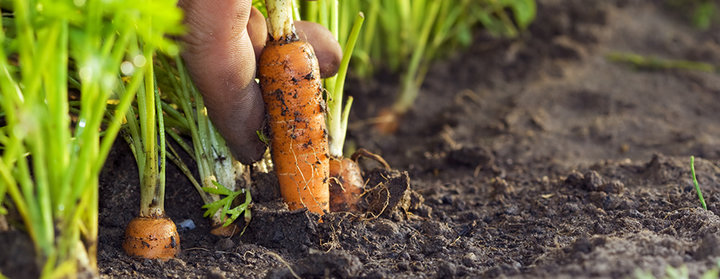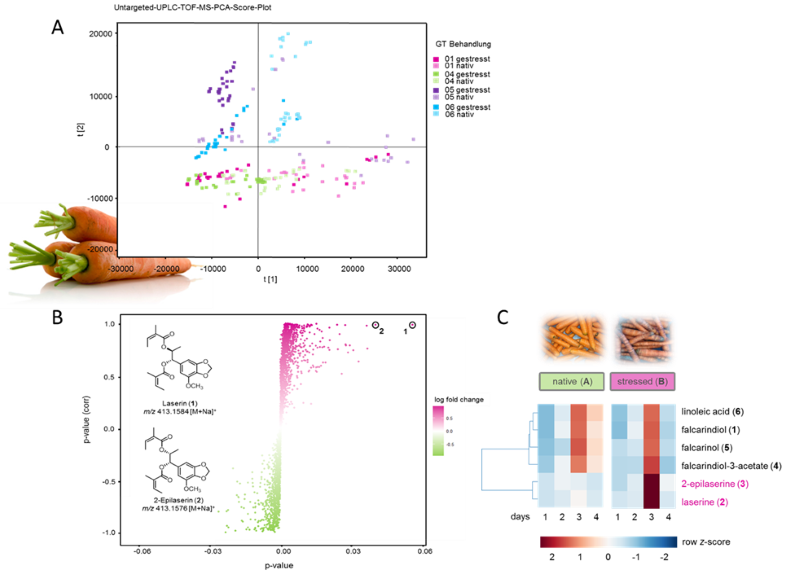
Plant Stress and Flavor
The agricultural sector focuses on enhancing plant yields and fitness; however, it is also known that plant stress affects plant quality aspects such as flavor code. The expression of genes controlling the biosynthesis of flavor stimuli is influenced by biotic and abiotic stress factors. Mild abiotic and biotic stress challenges or beneficial fungi may lead to an increase in tastants or odorants and hence to a more intense flavor impression and better crop quality. Conversely, stress challenges during the growing period or post-harvest storage may lead to off-flavor formation. The research group of Prof. Corinna Dawid is using the SENSOMICS approach (as highlighted above) to characterize flavor alterations in crops induced by abiotic and biotic stress challenges, as well as by beneficial fungi such as arbuscular mycorrhiza.
An example of the influence of mechanical stress on the metabolome of different carrot genotypes is displayed in Figure 1. To translate into breeding programs the knowledge of how stress-resistant traits mount a successful defense against stress conditions, genotype-specific metabolome alterations are characterized and gene clusters controlling the biosynthetic pathways of key stress metabolites are identified through genome-wide association studies. This research approach will help to navigate breeding programs and optimize pre- and post-harvest treatment of plant-derived food products from producer to consumer/processor to advance the production of high-quality foods.
 |
SELECTED PUBLICATIONS:
Mittermeier, V. K.; Hofmann, T.; Dawid, C.* Mitigating off-flavors of plant-based proteins. J. Agric. Food Chem. 2021, 69(32), 9202–9207.
Schmid, C.; Mittermeier-Kleßinger, V.; Peters, V. C. T.; Berger, F.; Kramler, M.; Heuberger, H.; Rinder, R.; Hofmann, T.; Gutjahr, C.; Dawid, C.* Quantitative mapping of flavor and pharmacologically active compounds in European licorice roots (Glycyrrhiza glabra L.) in response to growth conditions and arbuscular mycorrhiza symbiosis. J. Agric. Food Chem. 2021, 69(44), 13173–13189.
Schmid, C.; Dawid, C.; Peters, V.; Hofmann, T. Structure determination of saponins in European licorice roots (Glycyrrhiza glabra L.). J. Nat. Prod. 2018, 81(8), 1734–1744.
Schmid, C.; Sharma, S.; Stark, T.D.; Günzkofer, D.; Hofmann, T.F.; Ulrich, D.; Dunemann, F.; Nothnagel, T.; Dawid, C.* Influence of the abiotic stress conditions, waterlogging and drought, on the bitter sensometabolome as well as agronomical traits of six genotypes of Daucus carota. Foods 2021, 10(7), 1607.
Gläser, P.; Mittermeier-Kleßinger, V. K.; Spaccasassi, A.; Hofmann, T.; Dawid, C.* Quantification and bitter taste contribution of lipids and their oxidation products in pea-protein Isolates (Pisum sativum L.). J. Agric. Food Chem. 2021, 69(31), 8768–8776.
Utz, F.; Spaccasassi, A.; Kreissl, J.; Stark, T.D.; Tanger, C.; Kulozik, U.; Hofmann, T.; Dawid, C.* Sensomics-assisted aroma decoding of pea protein isolates (Pisum sativum L.). Foods 2022, 11, 412.
Peters, V. C. T.; Dunkel, A.; Frank, O.; McCormack, B.; Dowd, E.; Didzbalis, J.; Dawid, C.*; Hofmann, T. A high throughput toolbox for comprehensive flavor compound mapping in Mint. Food Chem. 2021, 365, 130522.
Peters, V. C. T.; Dunkel, A.; Frank, O.; Rajmohan, N.; McCormack, B.; Dowd, E.; Didzbalis, J.; Gianfagna, T. J.; Dawid, C.*; Hofmann, T. High-Throughput Flavor Analysis and Mapping of Flavor Alterations Induced by Different Genotypes of Mentha by Means of UHPLC-MS/MS. J. Agric. Food Chem. 2022.
Lainer, J.#; Dawid, C.#; Dunkel, A.; Gläser, P.; Wittl, S.; Hofmann, T. Characterization of bitter-tasting oxylipins in poppy seeds (Papaver somniferum L.). J. Agric. Food Chem. 2020, 68(38), 10361–10373.